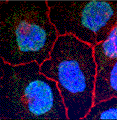Biochemistry, Department of
Document Type
Article
Date of this Version
2018
Citation
Neurobiol Dis. 2018 June ; 114: 45–52. doi:10.1016/j.nbd.2018.01.017.
Abstract
Objective: Adenosine participates in maintaining the excitatory/inhibitory balance in neuronal circuits. Studies indicate that adenosine levels in the cortex and hippocampus increase and exert sleep pressure in sleep-deprived and control animals, whereas in epilepsy reduced adenosine tone promotes hyperexcitability. To date, the role of adenosine in pathological conditions that result in both seizures and sleep disorders is unknown. Here, we determined adenosine tone in sleep and seizure regulating brain regions of Kv1.1 knockout (KO) mice, a model of temporal epilepsy with comorbid sleep disorders.
Methods: 1) Reverse phase-high performance liquid chromatography (RP-HPLC) was performed on brain tissue to determine levels of adenosine and adenine nucleotides. 2) Multi-electrode array extracellular electrophysiology was used to determine adenosine tone in the hippocampal CA1 region and the lateral hypothalamus (LH).
Results: RP-HPLC indicated a non-significant decrease in adenosine (~50%, p = 0.23) in whole brain homogenates of KO mice. Regional examination of relative levels of adenine nucleotides indicated decreased ATP and increased AMP in the cortex and hippocampus and increased adenosine in cortical tissue. Using electrophysiological and pharmacological techniques, estimated adenosine levels were ~35% lower in the KO hippocampal CA1 region, and 1–2 fold higher in the KO LH. Moreover, the increased adenosine in KO LH contributed to lower spontaneous firing rates of putative wake-promoting orexin/hypocretin neurons.
Interpretation: This is the first study to demonstrate a direct correlation of regionally distinct dichotomous adenosine levels in a single model with both epilepsy and comorbid sleep disorders. The weaker inhibitory tone in the dorsal hippocampus is consistent with lower seizure threshold, whereas increased adenosine in the LH is consistent with chronic partial sleep deprivation. This work furthers our understanding of how adenosine may contribute to pathological conditions that underlie sleep disorders within the epileptic brain.
Included in
Biochemistry Commons, Biotechnology Commons, Other Biochemistry, Biophysics, and Structural Biology Commons

